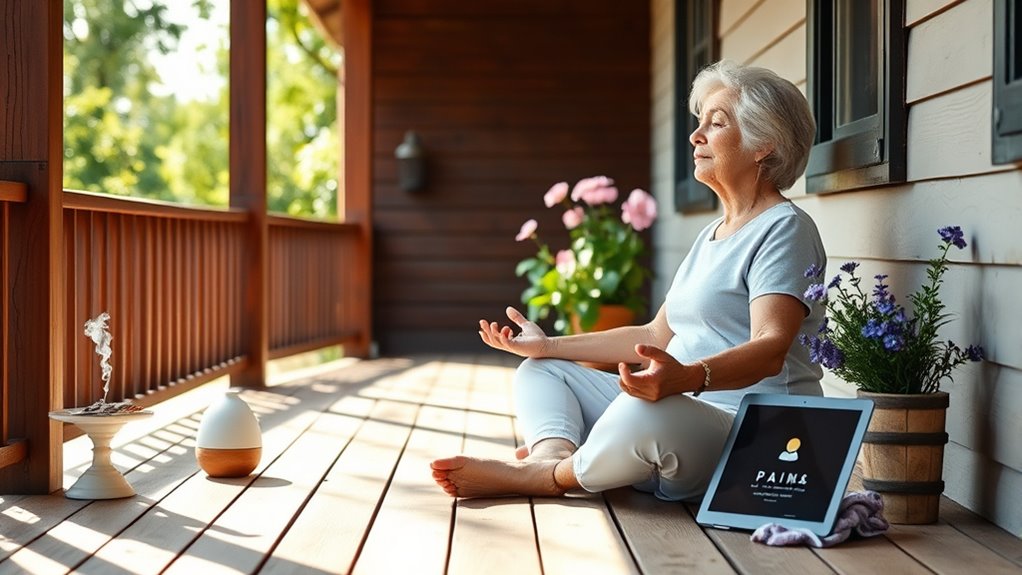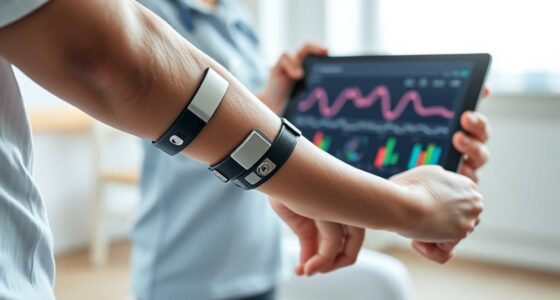To manage chronic pain without opioids, focus on staying active with gentle exercises like walking or swimming, which strengthen muscles and boost mood. Try complementary therapies such as acupuncture or mindfulness meditation to help relax and reduce pain. Make lifestyle changes like eating nutritious foods, getting enough sleep, and managing stress. Work closely with your healthcare provider to develop a personalized plan, and you’ll find more effective options to improve your quality of life.
Key Takeaways
- Incorporate gentle, low-impact exercises like walking or swimming to improve mobility and reduce pain.
- Utilize complementary therapies such as acupuncture, massage, and mindfulness meditation for natural pain relief.
- Develop personalized pain management plans with healthcare providers, emphasizing non-opioid medications and physical therapy.
- Make dietary and lifestyle changes, including nutritious foods, good sleep, stress management, and hydration, to support healing.
- Collaborate actively with healthcare teams to tailor treatments, track triggers, and adjust strategies for effective pain control.
Embracing Physical Activity and Exercise
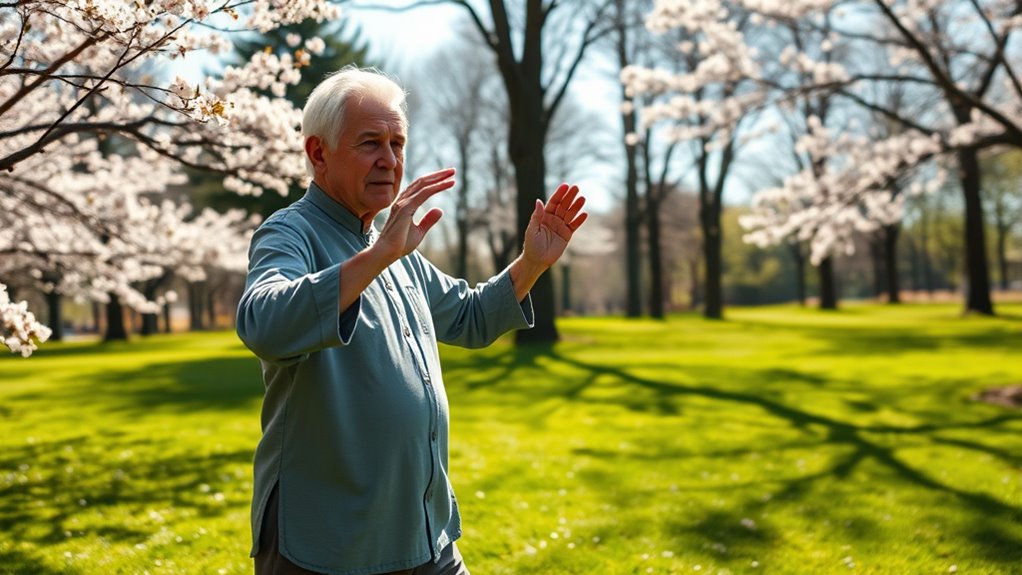
While it might seem counterintuitive, engaging in regular physical activity can substantially reduce chronic pain. Moving your body helps strengthen muscles, improve flexibility, and boost circulation, all of which can alleviate discomfort. You don’t need intense workouts; gentle activities like walking, swimming, or tai chi are effective and easier on your joints. Consistency is key—aim for at least 150 minutes of moderate exercise weekly, but start slowly and gradually increase your activity level. Exercise also releases endorphins, your natural painkillers, which can improve your mood and reduce perception of pain. Additionally, automation technologies enable scalable and flexible ways to support physical therapy programs remotely. Incorporating appropriate equipment such as resistance bands or balance aids can further enhance your exercise routine and safety. Remember, listening to your body is vital; if something hurts, modify or stop. Creating a supportive environment can motivate you to stay committed to your activity routine. Incorporating physical activity into your routine can empower you to manage pain more effectively and support recovery, as well as reduce stress and improve overall well-being.
Utilizing Complementary and Alternative Therapies
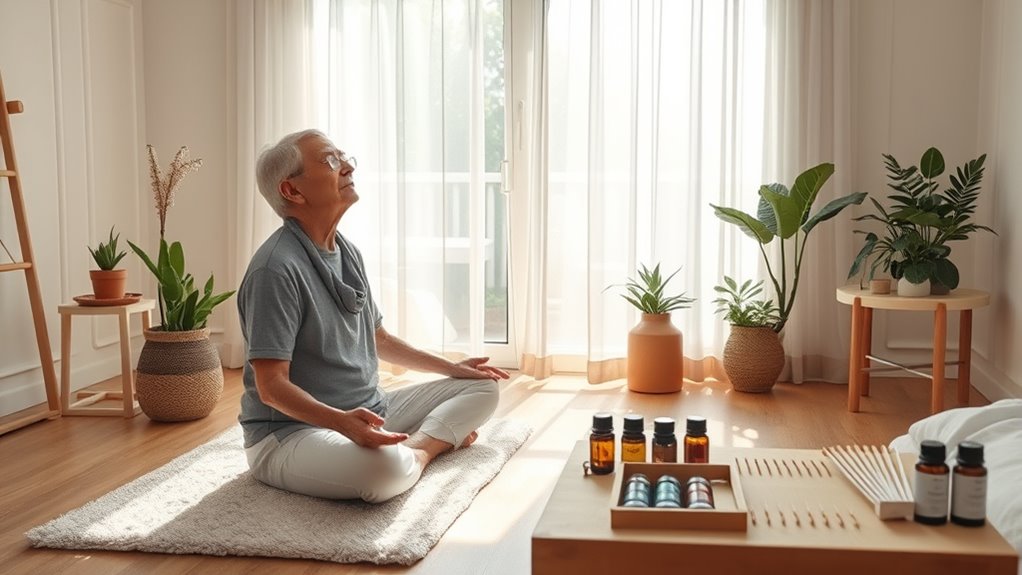
Complementary and alternative therapies can offer valuable options for managing chronic pain alongside conventional treatments. These approaches can help reduce pain, improve function, and enhance your overall well-being. Techniques like acupuncture target specific pain points to release natural pain-relieving chemicals. Mindfulness meditation helps you manage pain through relaxation and mental focus. Massage therapy can ease muscle tension and improve circulation. Herbal supplements and natural remedies may also provide relief, but always consult your healthcare provider before use. Incorporating these therapies into your routine can empower you to take an active role in managing your pain, often with fewer side effects than medications. Understanding the role of heat styling tools like curling irons can also help you make informed choices about maintaining your appearance safely. Additionally, exploring emotional support strategies can be beneficial in coping with chronic pain and the emotional impact it may have. Remember, combining these methods with your existing treatment plan can optimize your comfort and quality of life.
Implementing Effective Pain Management Strategies

Developing effective pain management strategies requires a proactive approach that combines various techniques tailored to your specific needs. Start by working closely with your healthcare provider to create a personalized plan that includes non-opioid medications, physical therapy, and appropriate activity levels. Incorporate regular exercise and gentle stretching to improve mobility and reduce pain. Use relaxation techniques like deep breathing or mindfulness to help manage discomfort and stress. Keep track of your pain levels and triggers to identify patterns and adjust your strategies accordingly. Educate yourself about your condition and stay committed to your plan. Consistency and communication with your healthcare team are key to effectively managing pain and maintaining your quality of life without relying on opioids. Understanding your dream symbols and their meanings can also provide insights into emotional factors that may influence your pain experience. Additionally, integrating mind-body techniques can enhance your overall pain management approach and promote emotional well-being. It is also beneficial to explore evidence-based alternative therapies that support non-opioid pain relief options.
Making Dietary and Lifestyle Adjustments
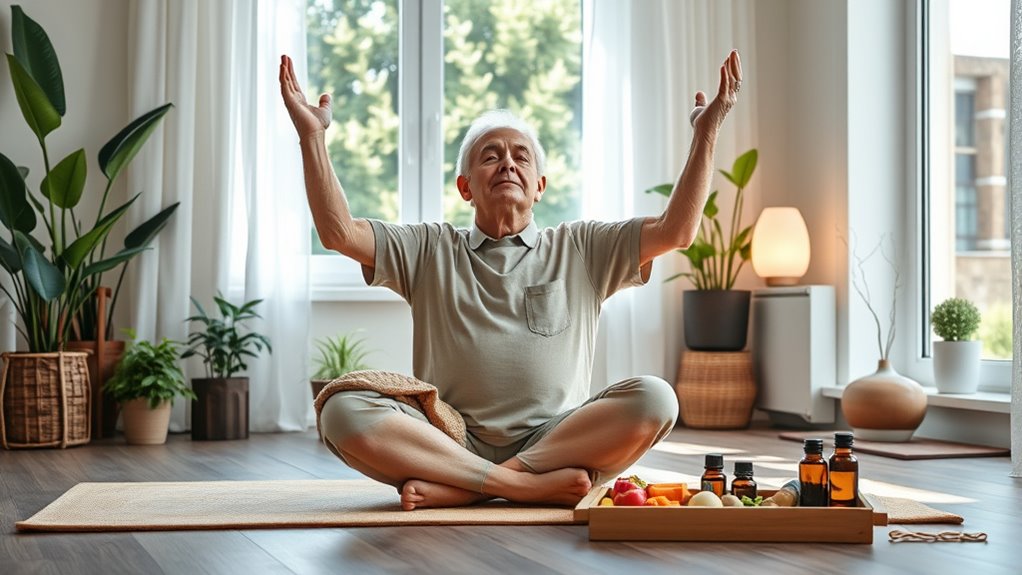
Making dietary and lifestyle adjustments plays a crucial role in managing chronic pain naturally. You can reduce inflammation and improve your overall well-being by choosing nutrient-rich foods and staying active. Incorporate more fruits, vegetables, lean proteins, and whole grains into your diet, and limit processed foods and sugars. Regular gentle exercise like walking or stretching can boost your mood and lessen pain. Prioritize good sleep, manage stress through meditation, and stay hydrated to support your body’s healing processes. Engaging in aquatic exercise can also provide a low-impact way to stay active and manage pain effectively. Remember, small daily changes can lead to significant relief over time. Incorporating a variety of dog names that suit your personality or lifestyle can also provide comfort and companionship during recovery. Here’s a glimpse of how lifestyle adjustments can touch your life:
| Food Choices | Activities | Emotional Well-being |
|---|---|---|
| Fresh vegetables | Daily walks | Improved mood |
| Whole grains | Gentle stretching | Reduced stress |
| Lean proteins | Mindfulness exercises | Better sleep |
| Limit processed foods | Staying hydrated | Greater energy |
Collaborating With Healthcare Providers for Personalized Care
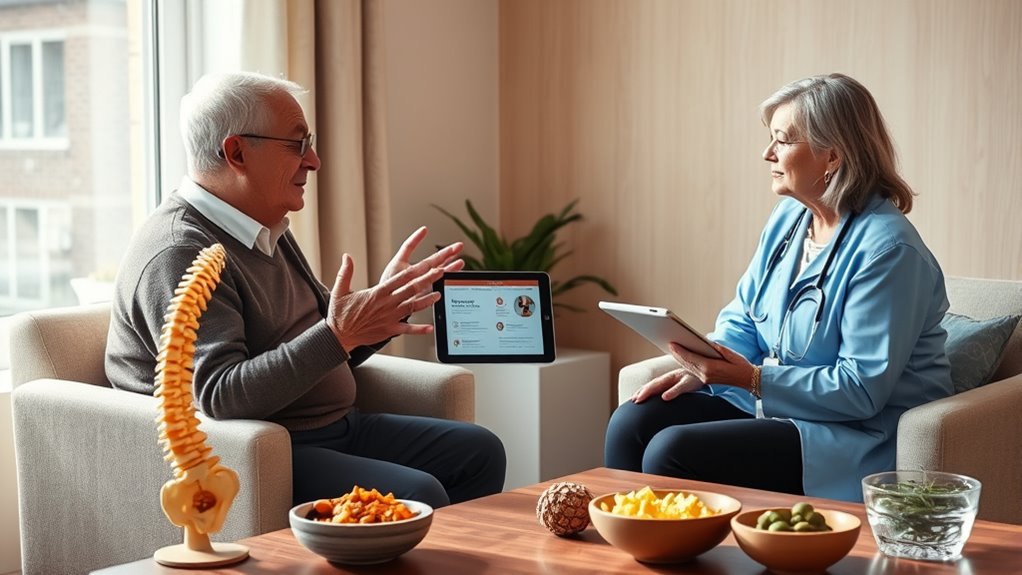
Have you considered how working closely with healthcare providers can tailor your pain management plan to suit your unique needs? Collaborating effectively guarantees your treatment aligns with your health status, lifestyle, and preferences. To make the most of this partnership: 1. Communicate openly about your symptoms, concerns, and goals, so your provider understands your experience clearly. 2. Ask questions about alternative therapies, medications, or lifestyle changes that could help manage your pain. 3. Follow up regularly to adjust your plan as your condition evolves, ensuring ongoing, personalized care. Recognizing that trust issues may arise in ongoing relationships can help you address concerns proactively and build a stronger partnership with your healthcare team. Being aware of toilet maintenance and repairs can also promote better health outcomes by preventing avoidable complications. Developing a comprehensive approach that includes multidisciplinary care and patient involvement ensures you receive support from various health professionals, which can enhance your pain management strategy. Additionally, understanding evidence-based practices can empower you to make informed decisions about your treatment options.
Frequently Asked Questions
How Can I Tell if My Pain Is Serious or Needs Urgent Care?
You should seek urgent care if your pain suddenly worsens, is severe, or doesn’t improve with usual treatments. Watch for symptoms like chest pain, weakness, numbness, difficulty breathing, or if the pain is associated with fainting, confusion, or severe dizziness. These signs could indicate a serious problem. Trust your instincts—if something feels wrong or alarming, don’t hesitate to get medical help immediately.
Are There Specific Exercises Suitable for Severe Chronic Pain?
Did you know that gentle exercises can reduce chronic pain by up to 30%? For severe pain, focus on low-impact activities like water aerobics, stretching, or tai chi, which are easier on your joints. Always listen to your body and start slowly. It’s best to consult your healthcare provider to develop a personalized exercise plan that safely helps manage your pain without causing harm.
What Are the Risks of Relying Solely on Alternative Therapies?
Relying solely on alternative therapies can pose risks like inadequate pain relief, which may lead to decreased mobility and quality of life. You might also delay seeking effective medical treatment, risking condition progression. Some therapies could cause side effects or interact with medications. It’s essential to combine these approaches with regular medical care, ensuring your pain management plan is safe, thorough, and tailored to your needs.
How Do I Communicate My Pain Concerns Effectively to My Doctor?
When you want to communicate your pain concerns effectively to your doctor, be clear and specific. Describe where it hurts, how intense it is, and when it occurs. Keep a pain journal to track patterns and triggers. Don’t hesitate to ask questions or express your worries. Use simple language, stay honest, and advocate for yourself confidently to guarantee your concerns are understood and addressed properly.
Can Lifestyle Changes Completely Eliminate Chronic Pain in Older Adults?
Think of your body as a garden; with proper care, weeds of pain can be kept at bay. Lifestyle changes like regular exercise, healthy eating, and stress management can markedly reduce chronic pain, but they might not completely eliminate it. You’re planting seeds for better health, yet some stubborn weeds may still linger. So, while lifestyle tweaks help, they often work best alongside other treatments for full relief.
Conclusion
By weaving these strategies into your daily life, you transform the battle against chronic pain into a journey of empowerment. Think of it as steering your ship through calm waters rather than battling stormy seas. Embrace movement, explore holistic options, and work closely with your healthcare team. With each step, you’re lighting a beacon of hope, guiding yourself toward a brighter, pain-free horizon where you’re the captain of your well-being.
